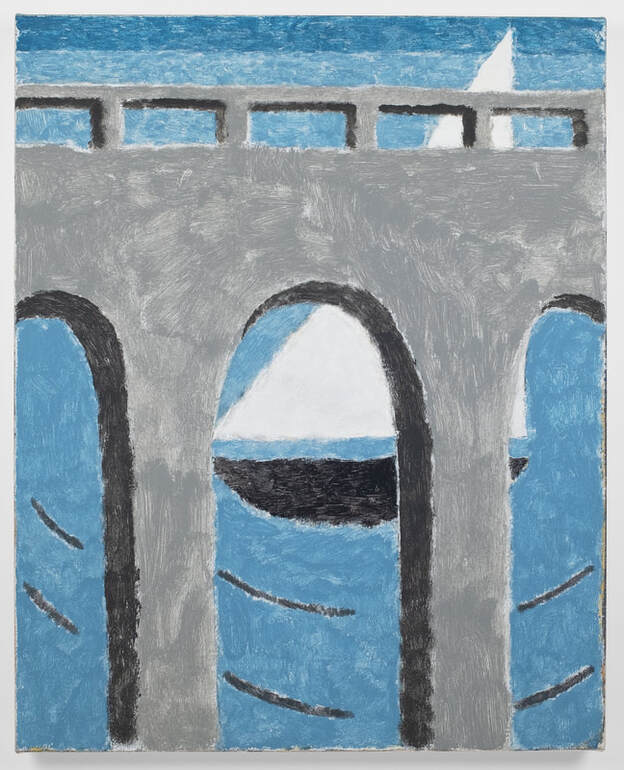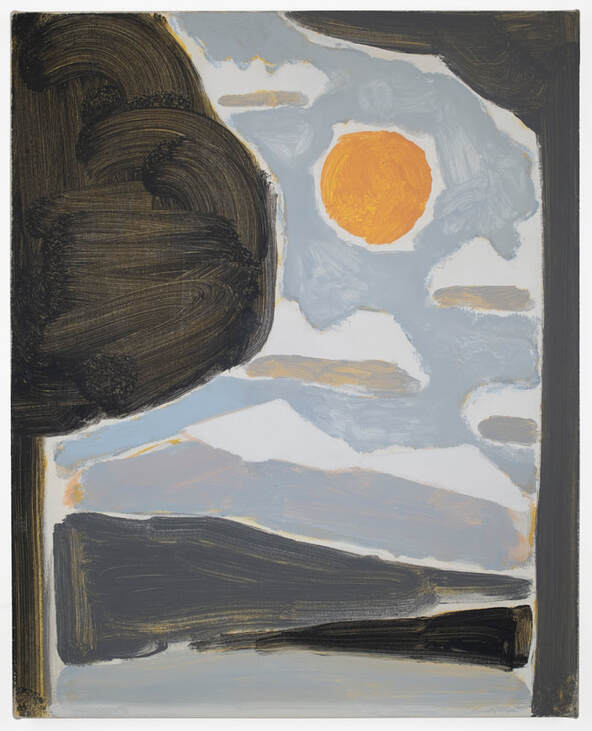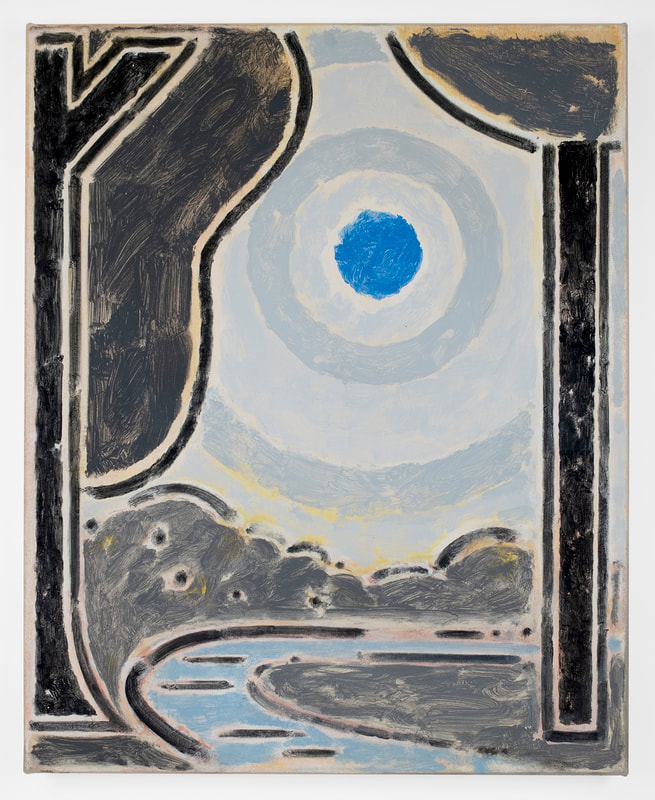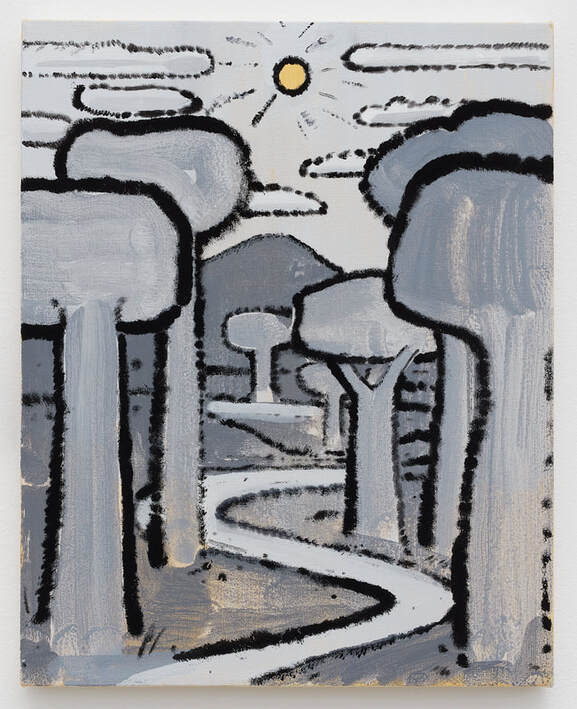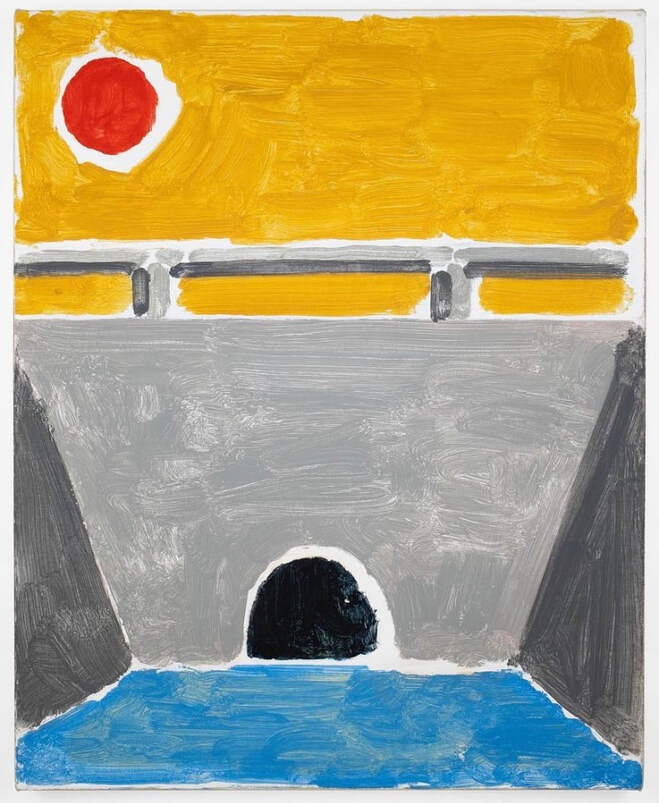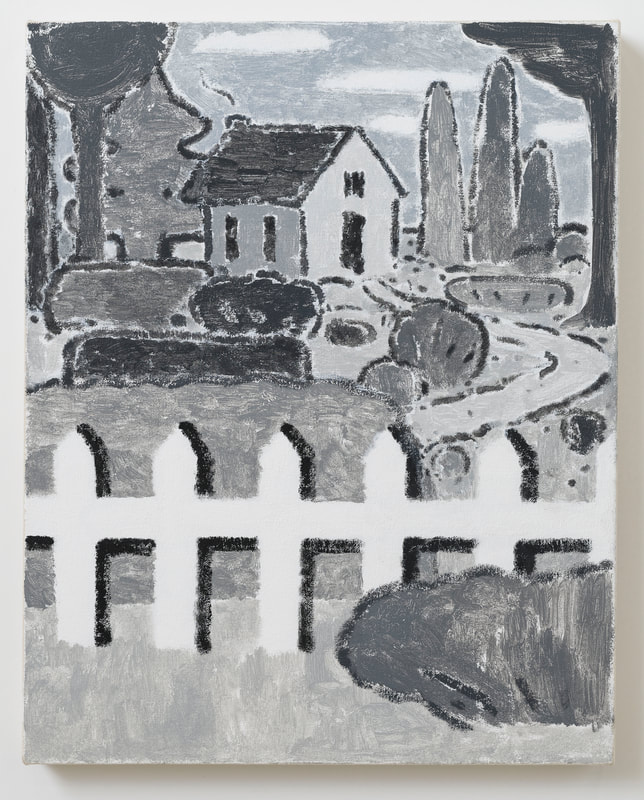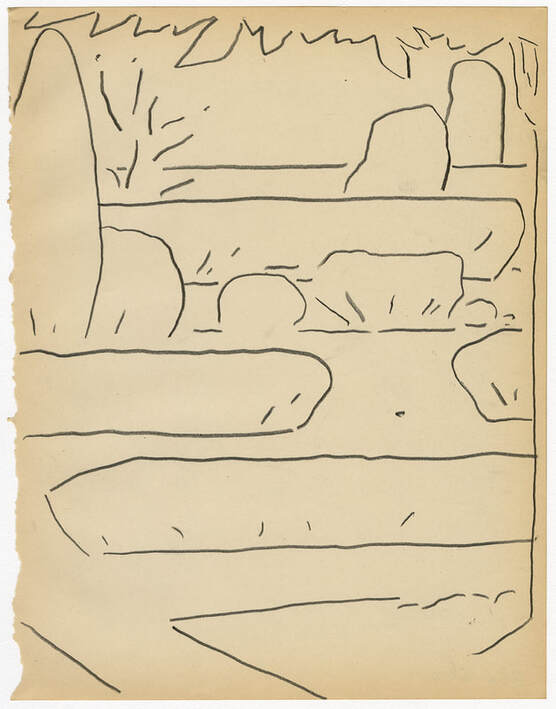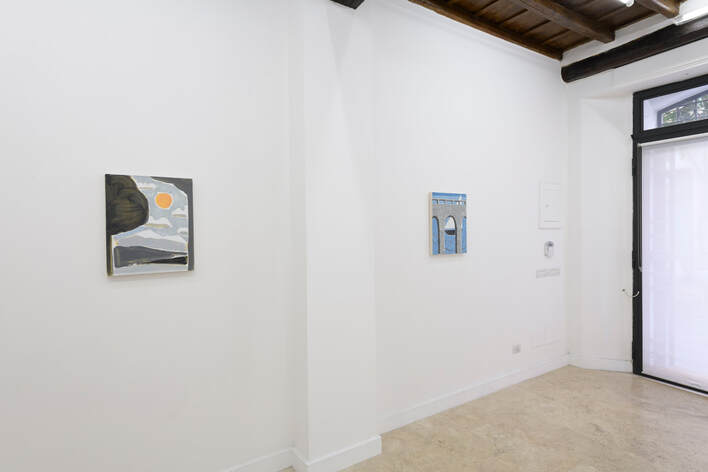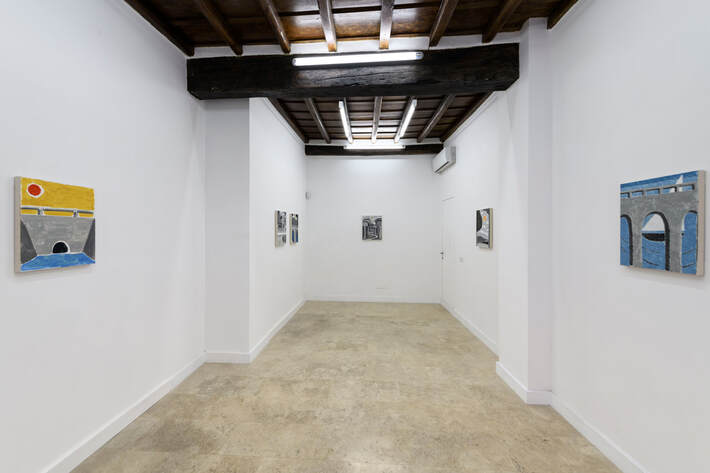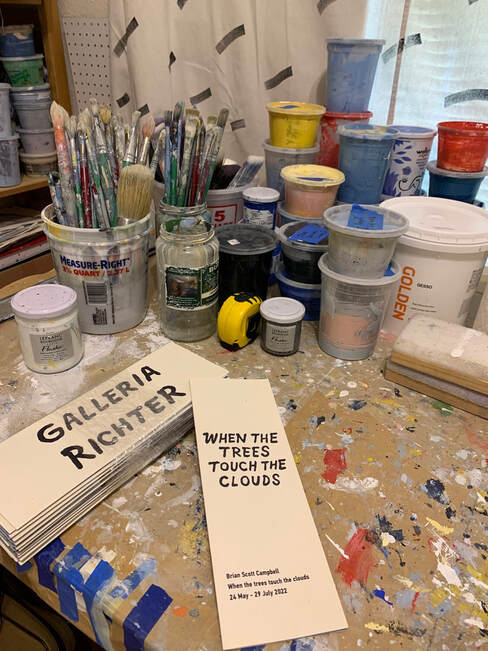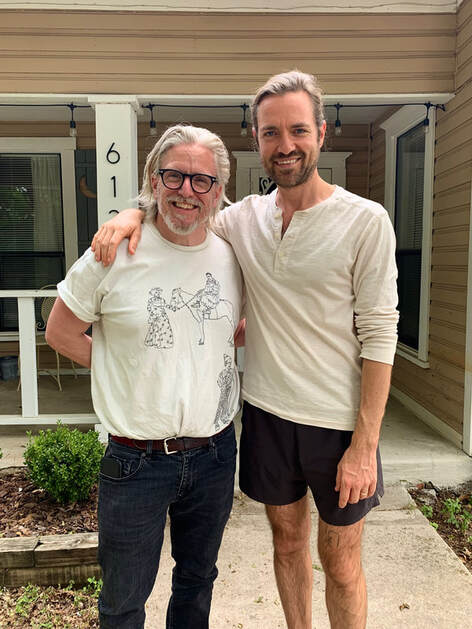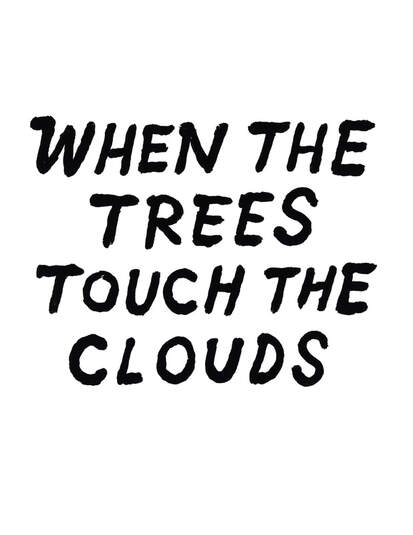|
7/7/2022 1 Comment #12: 7/7/2022My Foolish Boat Leaning- on the Work of Brian Scott Campbell by Benjamin Terrell This column was originally published in When the Trees Touch the Clouds, the catalog for Brian Scott Campbell's show by the same name at Galleria Richter in Rome, Italy (May 24 -July 29, 2022). Stone Bridge 2020, flashe on canvas, 20" x 16" I recently read about a decommissioned lighthouse for sale off the coast of Oregon. Inactive since the fifties, the building and grounds, built on basalt rock a mile from shore, had been repurposed as a columbarium until it was found the ocean air ate away at the metal urns. The business, long since defunct, only ended up interring the ashes of thirty people. Thirty strangers never knowing, their urns like paintings inverted, both ashes and earth articulated and offered to eternity as its audience. Great art, too, is exhumed and expressed from a place between description and dissolution. Art is the closest thing to continual resurrection, temporarily suspending and recycling everything that will eventually slip away. People also are culminations of everything that came before, we are complex soil for future blooms we will not live to see. Mellon 2021, flashe on canvas, 20" x 16" Painter Marsden Hartley incorporated figures into his work only in the last six years of his life. Hartley's later years were spent on the coast in Maine where the sea air eroded his previous artistic alphabet, out of which emerged herculean men and drowned sailors. Painted figures brawny as oversized beach rock, blocks of flesh and color so similar to the local landscape even when omitted their presence is felt. A mountain seen again is a mighty being and a stack of beached logs are bodies or even imagine the multiple limbs of an Indian deity expressing its omnipotence. It was important to Hartley that he reimagine his environment on canvas coarsely, to emulate how the ocean reshapes the shore or is meant to feel like the momentum of a lover overtaking the beloved in the act of its expression. Perhaps the artist wished to finally release everything in his lifetime that he could not consume. Oar 2022, flashe on canvas, 20" x 16" T.S. Eliott described a river as, "a strong brown god," but also imagined, "the river within us" as emptying into a sea that measures time outside of the ability to control it. "The future futureless (where) time stops and time is never ending," seen as a vast open space where shores and separate sides are only of the minds making. In these waters we are great but insignificant buoys swayed only by effort and emotion, not by the sea but self. To view things exclusively from the perspective of the self is to be in, "a drifting boat with slow leakage," far away from the acknowledgement that we are separate from nothing. Ego is our broken oar that makes only small circles in a vast oceanless ocean. Reconciliation comes from recognition of mortal limitation and an equal untapped other side, as imagined in a "hint half guessed, the gift half understood, (that) is incarnation." Guiding Light 2019, flashe on canvas, 20" x 16" At the center of any important means of expression, like painting, is a creative contradiction. The act of depicting is achieved through essential simplification to make things more relatable. What appears to be the artist orchestrating choices is only one part of a polarity being established, the other half propelled by everything that cannot be expressed or known. Together these opposing forces are a dialogue seen in the most successful works of art, just as similar contrary energies converse between life and death. We call our existence life because of our ability to articulate and document its act while we are in it, but an unknown other side is equally interwoven in every beginning and ending. Through creating and recreating every artist is reenacting one of mortality's greatest acknowledgements- our existence is equal parts life and death and best imagined as the magnetic momentum between both. Hot Dam 2021, flashe on canvas, 20" x 16" Karl Ove Knausgaard writes about an inevitable literary distance that is present in a painter's process and in the writing process. "All language casts a shadow, and that shadow can more or less be apprehended, but never quite controlled." That shadow is a space both writer and artist must pour themselves into in order to blend to one that takes action. But with every action something else is unshackled and all our disparate voices like urns undone, open to a creative chasm and greater dialogue. That expansive place is similar to the side of the cliff described in the Buddhist Koan about the tiger and the strawberry. In the anecdote a man chased off a cliff by one tiger, faced with another tiger beneath him, chooses to pick and eat a strawberry from a branch that he barely holds. The outcome of his life is inevitable but the opportunities for expression and expansion are the greatest choices exercised. Garden View 2020, flashe on canvas, 20" x 16" A painting drained of color like imagery reduced to its most basic shapes, as seen in the work of Brian Scott Campbell, is scenery seen one step closer to disappearing. Black and white (and grey or other limited palates) can feel past tense but also suggest other dualities like life and death and endings and beginnings. A painting can also be (to paraphrase a Sufi poem about stories) "like the water you heat for your bath that takes messages between the fire and your skin." It is a middle ground for consuming and concealing forces. The bones of a landscape- branches, a boat's mast and sail, a fence and everything beyond it, is the self further undressed and a realization that the part of us that observes is only the driver of a vehicle from which we must eventually disembark. When we cease to identify with, over interpret and project ourselves through a transient lens, we begin to merge and aid in our own disappearance. Untitled 1 2020, graphite on found paper, 10h" x 8" Most of my days begin or end with dog walks near the house at a large pond that is mostly drained. You can walk around what was the full pond or explore paths of overgrown vegetation and follow tracks of deer, elk and coyote in the pond's still soft bed. The reeds, trees and grasses are thin, tall and hard to see through and when walking there lately, I search for signs of a coyote cub I believe was recently abandoned by its pack. It occurs to me, the cub was left alone to assert its independence, where as we end our lives reminded of our own dependence. A landscape is always there to encourage us toward embodiment rather than estrangement. It looks back lovingly at us like we look at a painting. With all our strength and limitation, we are the field's favorite flower. We are the only unique bloom that thinks its self separate from the ground from which it grows. Untitled 1 2021, graphite on found paper, 10" x 8" Above and below: Installation views of When the Trees Touch the Clouds, Campbell's show at Galleria Richter Fine Art. 24 May – 29 July 2022Rome, Italy The artist's studio. Above: Benjamin Terrell (left) visiting Brian Scott Campbell at his home and studio in Denton, Texas.
Below: you can order a copy of the catalog for Campbell's show at: [email protected]
1 Comment
3/26/2024 01:55:16 pm
"Notes of Persistent Awe" is a fascinating project. The way it explores the intersection of nature, art, and human connection is truly inspiring. I particularly enjoyed the meditations on landscape painting and the idea of us acting as "mirror holders of life's greatest illusions." I'm eager to delve deeper and see where Benjamin Terrell's contemplations take us next.
Reply
Leave a Reply. |
|
